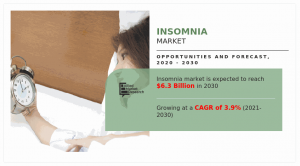What Factors Will Drive the Insomnia Market to Reach $6.3 billion by 2030?
PORTLAND, OREGON, UNITED STATES, July 18, 2023/EINPresswire.com/ -- The realm of sleeplessness, commonly known as the insomnia market, witnessed a remarkable valuation of $4.3 billion in the year 2020. Anticipations soar as projections forecast its ascending trajectory, surging towards a colossal milestone of $6.3 billion by the year 2030. This ascent represents a steady compound annual growth rate (CAGR) of 3.9%, meticulously calculated from the year 2021 to the year 2030. Within this evolving landscape, the insomnia market shines as a promising domain, captivating both the attention and investments of individuals and businesses alike.
Insomnia, a pervasive sleep disorder, disrupts the delicate balance of rest and wakefulness, encompassing various challenges such as difficulty falling asleep, maintaining sleep, or experiencing early awakenings with subsequent difficulty returning to slumber. This complex condition can arise from a multitude of factors, ranging from the weight of stressors to irregular sleep patterns and inadequate sleep hygiene practices. Mental health disorders, including anxiety and depression, often intertwine with insomnia, amplifying its impact on sleep quality. Furthermore, physical illnesses and pain, as well as certain medications, can contribute to the manifestation of insomnia symptoms. Neurological issues and specific sleep disorders further complicate the landscape, illustrating the intricate web that insomnia weaves within the realm of sleep disorders. Understanding these diverse causes is crucial in developing effective strategies to mitigate the challenges faced by individuals grappling with insomnia.
𝐃𝐨𝐰𝐧𝐥𝐨𝐚𝐝 𝐒𝐚𝐦𝐩𝐥𝐞 𝐑𝐞𝐩𝐨𝐫𝐭: https://www.alliedmarketresearch.com/request-sample/2373
Key Market Players
1. 𝐳𝐲𝐝𝐮𝐬 𝐜𝐚𝐝𝐢𝐥𝐚
2. 𝐌𝐈𝐍𝐄𝐑𝐕𝐀 𝐍𝐄𝐔𝐑𝐎𝐒𝐂𝐈𝐄𝐍𝐂𝐄𝐒
3. 𝐦𝐞𝐫𝐜𝐤 𝐤𝐠𝐚𝐚
4. 𝐝𝐚𝐫𝐦𝐬𝐭𝐚𝐝𝐭
5. 𝐠𝐞𝐫𝐦𝐚𝐧𝐲
6. 𝐕𝐚𝐧𝐝𝐚 𝐏𝐡𝐚𝐫𝐦𝐚𝐜𝐞𝐮𝐭𝐢𝐜𝐚𝐥𝐬
7. 𝐄𝐈𝐒𝐀𝐈
8. 𝐒𝐚𝐧𝐨𝐟𝐢
9. 𝐕𝐈𝐀𝐓𝐑𝐈𝐒
10. 𝐂𝐔𝐑𝐑𝐀𝐗 𝐏𝐇𝐀𝐑𝐌𝐀𝐂𝐄𝐔𝐓𝐈𝐂𝐀𝐋𝐒
11. 𝐏𝐟𝐢𝐳𝐞𝐫
12. 𝐓𝐚𝐤𝐞𝐝𝐚 𝐏𝐡𝐚𝐫𝐦𝐚𝐜𝐞𝐮𝐭𝐢𝐜𝐚𝐥 𝐂𝐨𝐦𝐩𝐚𝐧𝐲
𝐈𝐧𝐬𝐨𝐦𝐧𝐢𝐚 𝐌𝐚𝐫𝐤𝐞𝐭 𝐑𝐞𝐩𝐨𝐫𝐭 𝐇𝐢𝐠𝐡𝐥𝐢𝐠𝐡𝐭𝐬
1. Non-Pharmacological Therapy: Non-pharmacological therapies focus on managing insomnia without the use of medication. These interventions typically target the underlying causes and symptoms of insomnia and aim to promote healthy sleep habits. Some common non-pharmacological therapies for insomnia include:
• Cognitive Behavioral Therapy for Insomnia (CBT-I): CBT-I is a widely recognized therapy that addresses the psychological and behavioral aspects of insomnia. It involves various techniques such as sleep hygiene education, stimulus control, sleep restriction, relaxation techniques, and cognitive restructuring.
• Sleep Restriction Therapy: This therapy involves limiting the time spent in bed to increase sleep efficiency and consolidate sleep.
• Relaxation Techniques: Techniques such as progressive muscle relaxation, deep breathing exercises, guided imagery, and mindfulness meditation can help reduce stress and induce relaxation for better sleep.
• Stimulus Control Therapy: This therapy focuses on creating a sleep-conducive environment and associating the bed with sleep rather than wakefulness.
2. Pharmacological Therapy: Pharmacological therapies involve the use of medications to manage insomnia symptoms. These medications can be prescribed based on the individual's specific needs and medical history. Common pharmacological options for insomnia include:
• Sedative-Hypnotic Medications: These medications, such as benzodiazepines (e.g., diazepam) and non-benzodiazepine receptor agonists (e.g., zolpidem), act on the central nervous system to induce sleep.
• Melatonin Receptor Agonists: Melatonin receptor agonists (e.g., ramelteon) target the body's natural sleep-wake cycle and help regulate sleep patterns.
• Orexin Receptor Antagonists: Orexin receptor antagonists (e.g., suvorexant) work by blocking the orexin system, which plays a role in promoting wakefulness.
𝐍𝐨𝐰, 𝐥𝐞𝐭'𝐬 𝐞𝐱𝐩𝐥𝐨𝐫𝐞 𝐭𝐡𝐞 𝐫𝐞𝐠𝐢𝐨𝐧𝐚𝐥 𝐛𝐫𝐞𝐚𝐤𝐝𝐨𝐰𝐧:
• North America: This region includes the United States, Canada, and Mexico. It represents a significant market for insomnia management, driven by factors such as high prevalence of insomnia, awareness about available therapies, and advanced healthcare infrastructure.
• Europe: The European market comprises countries like Germany, France, the United Kingdom, Italy, Spain, and other European nations. With a focus on healthcare advancements, increasing awareness, and rising adoption of insomnia therapies, this region contributes significantly to the market growth.
• Asia-Pacific: This region includes Japan, China, Australia, India, South Korea, Taiwan, and other Asia-Pacific countries. Factors such as a large population, increasing disposable income, growing healthcare infrastructure, and rising awareness about sleep disorders contribute to the expansion of the insomnia market in this region.
• LAMEA: Latin America, Middle East, and Africa (LAMEA) encompass countries such as Brazil, Turkey, Saudi Arabia, South Africa, and other regions. The market in LAMEA is influenced by improving healthcare facilities, rising awareness, and increasing demand for insomnia management solutions.
𝐅𝐑𝐄𝐐𝐔𝐄𝐍𝐓𝐋𝐘 𝐀𝐒𝐊𝐄𝐃 𝐐𝐔𝐄𝐒𝐓𝐈𝐎𝐍𝐒?
1. What are some emerging trends in the insomnia market that are shaping its growth?
2. How does the prevalence of mental health disorders impact the demand for insomnia therapies in the market?
3. Are there any specific age groups or demographics that are driving the growth of the insomnia market?
4. What are the major challenges faced by companies operating in the insomnia market?
5. How is technology being integrated into insomnia management, and what role does it play in the market?
6. What regulatory factors influence the development and commercialization of insomnia therapies in different regions?
7. Are there any innovative non-pharmacological therapies being explored for insomnia management?
8. What are the key strategies adopted by leading players in the insomnia market to gain a competitive edge?
9. How does the pricing and reimbursement landscape impact the adoption of insomnia therapies in different markets?
10. What role does patient education and awareness play in driving the demand for insomnia management solutions in the market?
𝐏𝐮𝐫𝐜𝐡𝐚𝐬𝐞 𝐏𝐫𝐞𝐦𝐢𝐮𝐦 𝐂𝐨𝐩𝐲 𝐨𝐟 𝐈𝐧𝐬𝐨𝐦𝐧𝐢𝐚 𝐌𝐚𝐫𝐤𝐞𝐭 𝐆𝐫𝐨𝐰𝐭𝐡 𝐑𝐞𝐩𝐨𝐫𝐭 𝐚𝐭: https://www.alliedmarketresearch.com/insomnia-market/purchase-options
𝐁𝐫𝐨𝐰𝐬𝐞 𝐌𝐨𝐫𝐞 𝐑𝐞𝐩𝐨𝐫𝐭𝐬:
VR in Healthcare Market - https://www.alliedmarketresearch.com/vr-in-healthcare-market-A06193
Remote Patient Monitoring Market - https://www.alliedmarketresearch.com/remote-patient-monitoring-market
David Correa
Allied Analytics LLP
1 800-792-5285
email us here
Legal Disclaimer:
EIN Presswire provides this news content "as is" without warranty of any kind. We do not accept any responsibility or liability for the accuracy, content, images, videos, licenses, completeness, legality, or reliability of the information contained in this article. If you have any complaints or copyright issues related to this article, kindly contact the author above.

